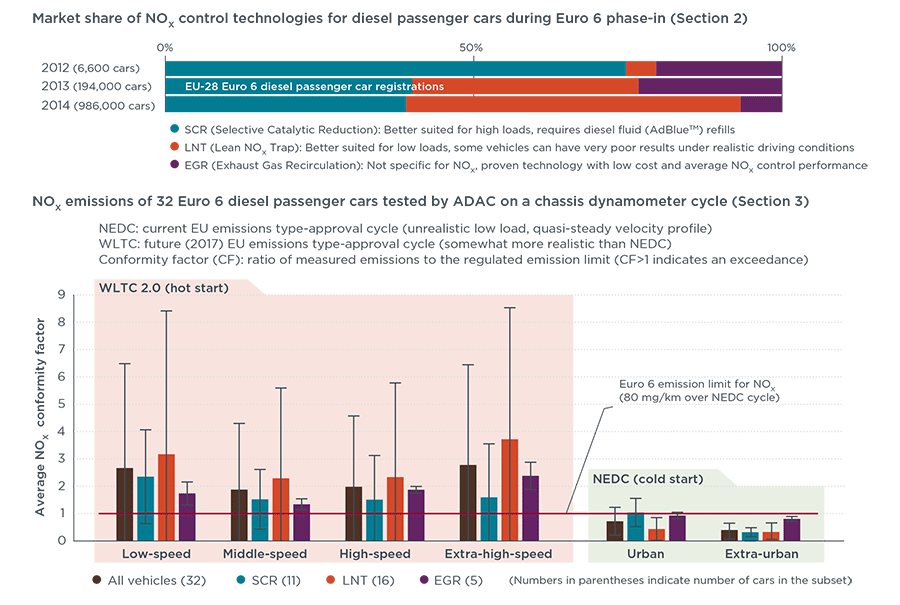White paper
NOx control technologies for Euro 6 diesel passenger cars
Controlling nitrogen oxide (NOx) emissions from Euro 6 diesel passenger cars is one of the biggest technical challenges facing automakers. Euro 6 limits NOx emissions from diesel passenger cars to 80 mg per kilometer, down from 180 mg/km for Euro 5 vehicles. The new limit value is not as stringent as it appears, because it applies to an outdated emissions certification driving cycle (the New European Driving Cycle, NEDC) that should be replaced by a more realistic one (the Worldwide Harmonized Light Vehicles Test Cycle, WLTC) from 2017 on.
But the biggest challenge for diesel passenger car manufacturers arises not from the certification cycle but from the real-driving emissions (RDE) test, which is scheduled to become a mandatory step for the type approval of passenger cars in the EU in January 2016. Under this new testing framework, diesel passenger cars will have to prove that they can keep NOx emissions at reasonably low levels during a test that more closely represents real-world driving situations.
This study analyzes the results of emissions tests performed by Europe’s largest car club, Allgemeiner Deutscher Automobil-Club as part of ADAC’s EcoTest program. These covered 32 Euro 6 diesel passenger cars from 10 different manufacturers, equipped with different types of exhaust aftertreatment technologies, tested over both the NEDC and WLTC driving cycles.
The findings indicate that the implementation of NOx control technologies by a few manufacturers is delivering acceptable results over both cycles, whereas other manufacturers are mostly focusing on meeting the limit over the NEDC while neglecting real-world operating conditions, even on the relatively low-load WLTC.
All vehicles tested except one met the legislative limit of 80 mg/km of NOx over the less demanding NEDC cycle. Most EGR- and SCR-equipped vehicles performed better than LNT-equipped vehicles over the WLTC, but their average emissions were still far higher than those over the NEDC (by a factor of 2.3 for EGR-equipped vehicles and 2.8 for SCR-equipped vehicles). The same factor was 8.0 for the average of all LNT-equipped vehicles. Three LNT-equipped vehicles exhibited very poor performance over the WLTC, with one car emitting up to 1,167 mg/km of NOx (15 times the regulated limit). This casts a shadow of doubt over the real-world performance of all current (pre-RDE) NOx control approaches, especially those relying on LNTs, and underscores the importance of engine and aftertreatment calibration to realize the full potential of available technologies and achieve satisfactory real-world performance.
The study appears as the European Commission is about to propose emissions limit multipliers that will apply to the new on-road vehicle emissions tests. These “conformity factors” will have a large impact on the deployment of emissions control technologies, and thus on the real-world emissions performance of new diesel cars.
Attachments
factsheet_NOx-control-tech_092015.pdf
zusammenfassung_NOx-control-tech_092015.pdf
NOx_ctrl-tech-fig_mod_0.png

